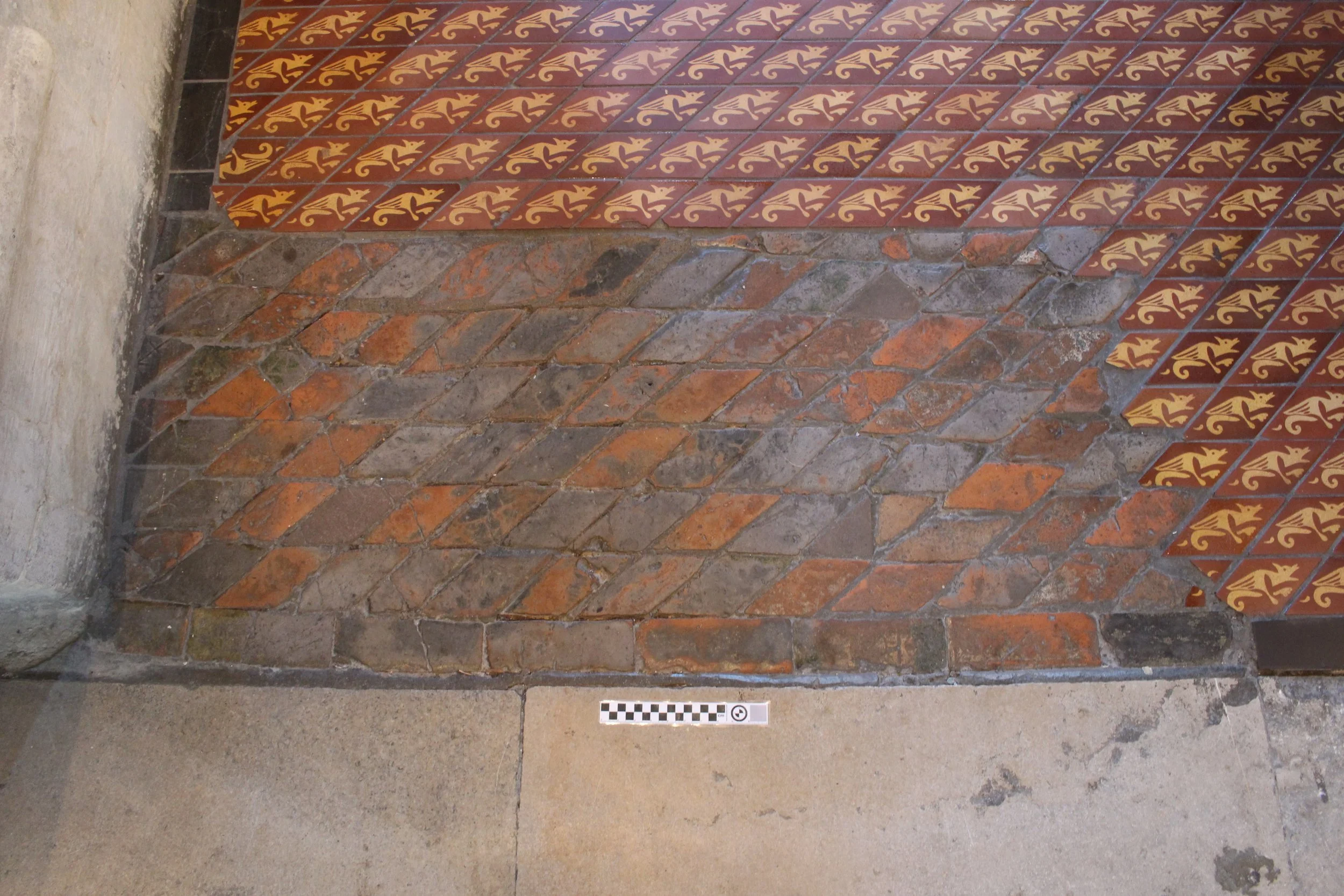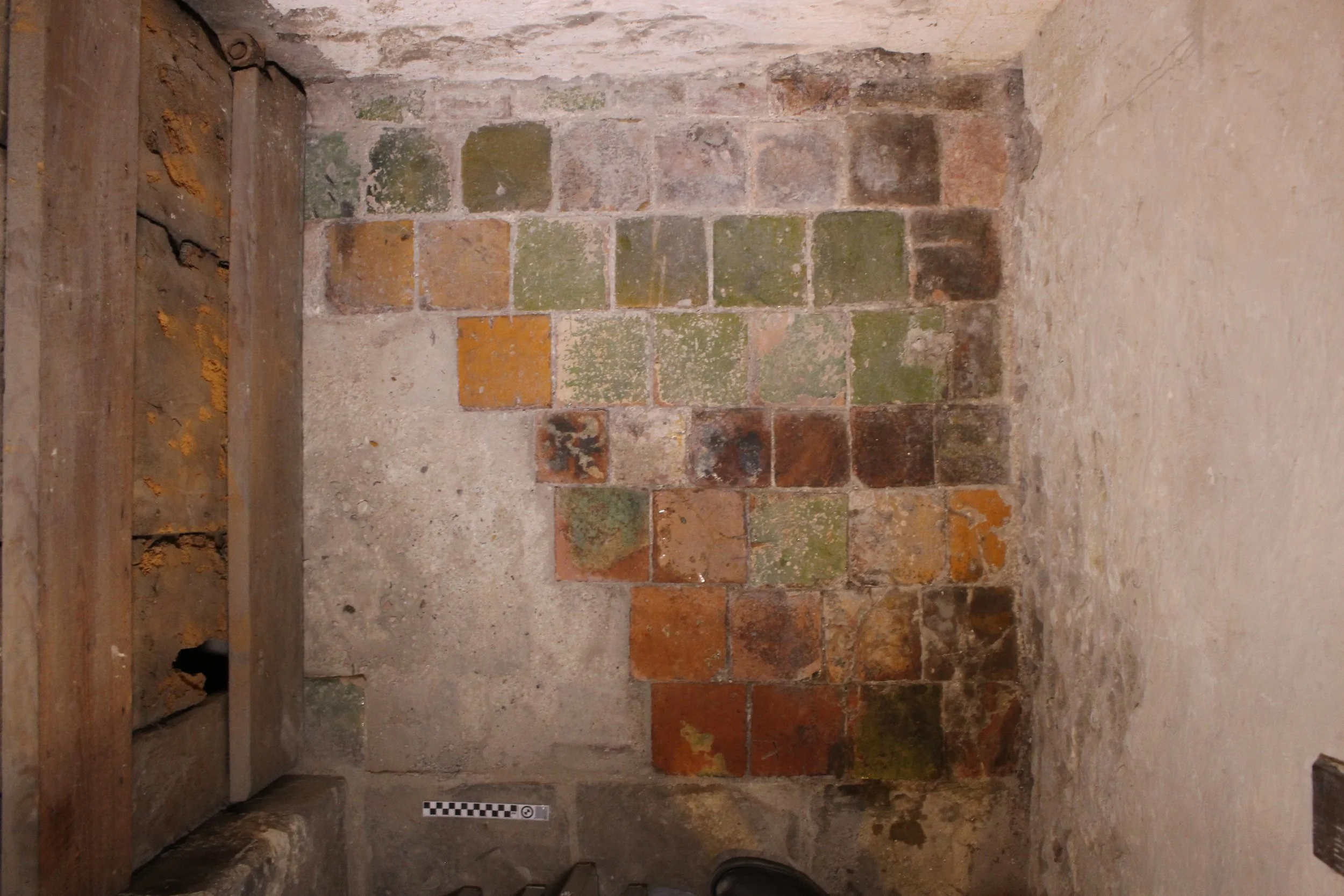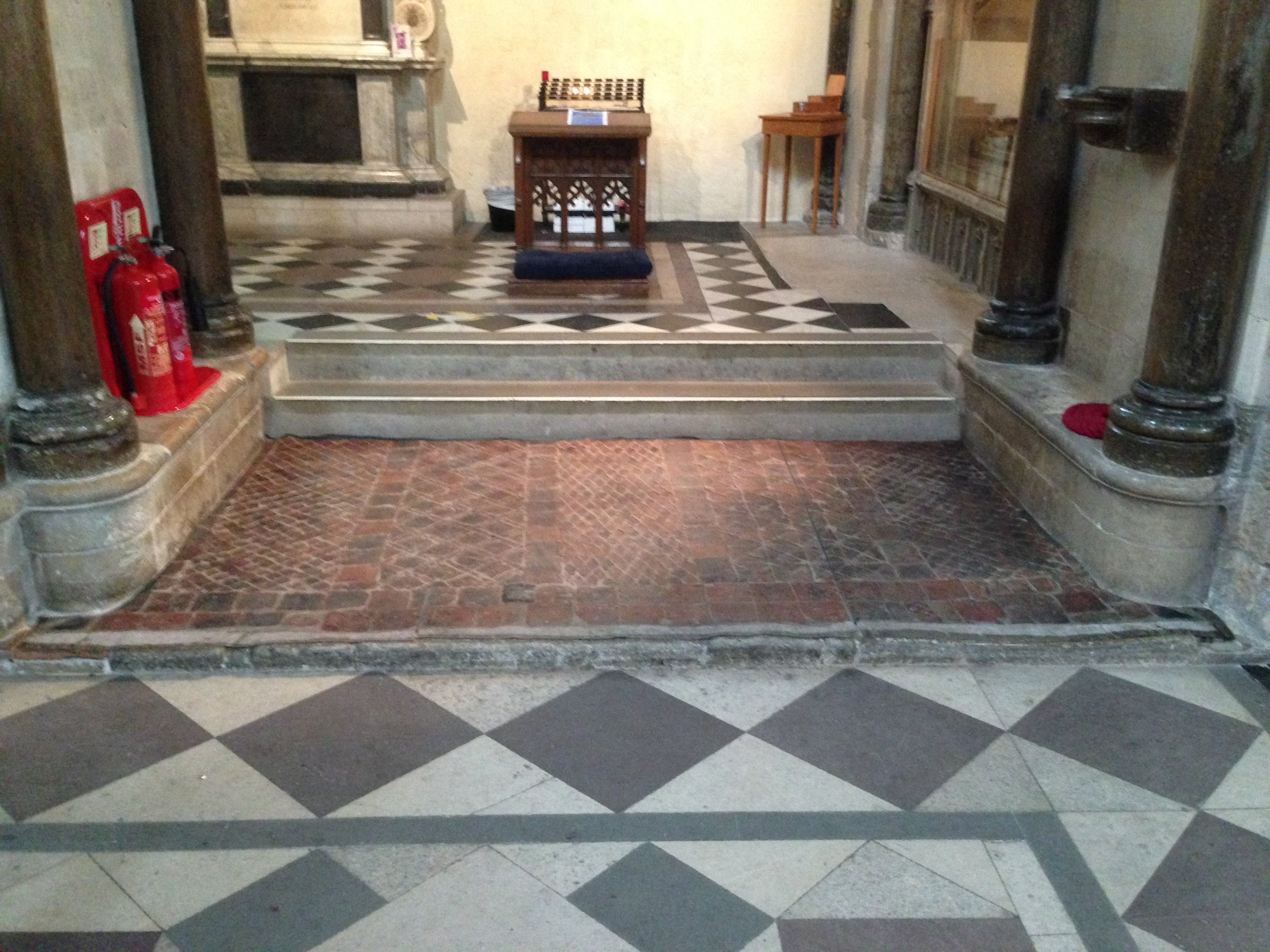Medieval floor tiles
/| Inscribed | Square tiles with hand-scored lines, drawn whilst the clay was wet, with white slip (clay slurry) applied to one side of the lines. |
| Mosaic | Small tiles of different shapes, sizes and colours used to produce patterns. Individual tiles were usually of a single colour |
| Square | Usually about 105 to 140 mm square, mostly commercially produced and either plain or decorated with two-colour patterns. The patterns were copied extensively during the Victorian period. |
Five common colours were produced by altering the glazes and selectively applying slip. They were red-brown, yellow, bright green, dark green and near black.2 Inscribed tiles are the earliest known in Kent and were used in the late 12th or early 13th century at Faversham Abbey3 and St Augustine's Abbey, Canterbury4 but none has been found at Rochester Cathedral. Rochester Cathedral's mosaic tile pavements are the finest of its surviving tiled areas. Similar pavements survive at other sites including the Corona at Canterbury Cathedral5 and at the Cistercian Abbeys of Meaux, Rievaulx and, particularly, Byland and Fountains in Yorkshire.6 Inscribed and mosaic tiles were usually produced in small-scale facilities close to the site where they were used, but after about 1290 they were largely abandoned in favour of plain and two-colour square tiles of standard sizes which were mass produced at commercial manufacturing centres. This production lasted throughout the 14th Century when these tiles were widely used in churches throughout England. The two-colour tiles usually had a yellow design against a red-brown background and there were numerous designs including the fleur-de-lys, heraldic shields, floral and geometric designs. Some square tiles were designed to form part of a larger pattern extending across square panels of four, nine or sixteen tiles. 7 8 Many tiles found in east Kent churches were made at the major medieval tile production centre at Tyler Hill north of Canterbury; they include Kent's best-preserved medieval tiled pavement at Brook church near Ashford®. Many churches in west Kent, including Rochester Cathedral, have similar tiles but it is not known whether they were produced at Tyler Hill or elsewhere - even where there was a local industry, tiles were sometimes brought from further afield. For example, whilst most of the tiles excavated at St Augustine's Abbey in Canterbury are believed to have been manufactured at Tyler Hill, some were made elsewhere in Kent, some perhaps made in or near London and some seem to have been imported from abroad.4 9 Rochester Cathedral once had extensive areas of medieval tiled pavement, particularly in the Presbytery, but during George Gilbert Scott's restoration in the 1870s the floor levels were changed and the floors covered with new tiles.10 Scott also moved the chest tomb of Bishop John Lowe from the centre of the north-east Transept to a tiled recess on its east side (Fig. 1 area E) - there may be medieval tiles surviving under Lowe's tomb. Hope recorded five 'portions of original tiled pavement' of which two (areas H and I) are now gone, although it is possible that the tiles from these areas were re-used to form three new areas (A, B and C), not recorded by Hope, when the area was re-tiled.11




Fig. 1. Location plan and photos of medieval tiles.
Mosaic tiles survive in three areas: E, F and G. Unfortunately the coloured surfaces have worn away, but Fig. 2 shows the five patterns used, thus:12
Figure 2: Mosaic tile patterns, after Hope, 1898.
| A | Red-brown and yellow square tiles, 45 mm, set diamond-wise. |
| B | Red-brown and yellow lozenge-shaped tiles, 100 × 45 mm (areas E and F) and 180 × 75 mm (area G). Many of the tiles in area G are irregularly shaped. |
| C | Yellow square tiles set diamond-wise of two sizes, 85 and 23 mm, and black rectangular tiles, 90 × 25 mm. |
| D | Black and yellow triangular tiles, 110 × 60 mm, forming squares. |
| E | Black triangular, 47 x 40 mm, yellow lozenge-shaped, 95 × 40 mm, and yellow square, 45 mm, tiles forming 8- and 12-sided overlapping polygons. The triangular tiles are probably cut lozenges. |
Similar tiles with the colours preserved have been excavated at a tile kiln site at Boxley Abbey,13 just seven miles south of Rochester, so it is quite possible that the Cathedral's mosaic tiles were produced there. Patterns a, b, c and e are also found at Byland and Fountains Abbeys6 There are now seven known areas of medieval tile in the Cathedral (areas A to G) as well as some loose ones in the Lapidarium and although most are very worn the slip decoration can still be made out in a few cases:
| A | Four rows of 19 tiles, 150 mm square, with two outside rows of tiles 120 mm square. Probably all re-used from elsewhere. |
| B | Behind a door. Mixed 150 and 120 mm square tiles, several loose and many missing with some loose fragments. At least two are decorated, one with a Fleur de Lys and another with a rider on a horse, both 150 mm square. This area needs further investigation. |
| C | 120 and 45 mm square tiles, many set diamond-wise. Some of the larger tiles are cut and some have remains of yellow decoration - one was apparently originally part of a four-tile panel. Some of the small square tiles also have remains of yellow decoration. Probably all re-used from elsewhere. |
| D | 120 mm square tiles, many set diamond-wise. Probably all re-used from elsewhere. |
| E | Fig. 3. The mosaic tiles are divided by 120 mm square tiles into four compartments with patterns (left to right): b, e, a, c. These are apparently in their original location. The front part has been repaired or extended with mostly 120 mm square tiles, some with patterns so probably reused. Tiles at the north end of the tomb are set diamond-wise and are plain, 115mm, and patterned, 130 mm - patterns include a fleur-de-lys, so presumably reused. Four are 225 mm, presumably post-medieval. |
| F | Fig. 4. The mosaic tiles are divided into five compartments with patterns (left to right): a, c, b, d, a. Two rows of 120 mm square tiles extend the tiled area. Apparently in their original location although restored with some replacements.14 |
| G | Large mosaic tiles (pattern b) edged by rectangular tiles or bricks on S side. Original colours uncertain. Surrounded by C19 two-colour tiles of similar size. |
Rochester Museum holds local slip-decorated square tiles including some discovered in 1976 in Prior's Gate House in the Cathedral Precincts.15 16 One has pale-yellow slip decoration of a flower enclosed in a circle, one has a dark green glaze, another has a yellow slip and others are plain. These tiles may suggest the decorative effect of the tiles in the Cathedral before the surfaces were worn away. The Museum also holds an unusual shaped medieval floor tile which was discovered in the garden of 110 Borstal Road and presented in 1946.16 It is a segment tile from a roundel which formed part of a large circular arrangement and it is decorated in a similar manner to the slip-decorated tiles of the 14th Century. Could this tile have come from a large floor in the Cathedral?
Gerald Cramp and David Carder
The authors acknowledge the assistance of Jacob Scott, in providing photographs and historical information, and the Research Guild for the base plan in Fig. 1.
Footnotes
1 For a summary of Kent's medieval floor tiles see Gerald Cramp, Ceramic Floor Tiles in Medieval Kent, Kent Archaeological Society Newsletter 103, Spring 2016 p. 16.
2 A useful summary is in Hans van Lemmen, Medieval Tiles, Shire Books (2004).
3 Incised tiles from Faversham Abbey are in the Fleur de Lys Museum, Faversham.
4 Medieval floor tiles from St Augustine's Abbey, Canterbury, are in the site museum.
5 Dated to c.1285-90. See E C Norton and M C Horton, A Parisian Workshop at Canterbury. A Late Thirteenth-Century Tile Pavement in the Corona Chapel, and the Origins of Tyler Hill, Journal of the British Archaeological Association Vol. 134 (1981) p.58-80.
6 Photos in Medieval Tiles, ret. 1.
7 Examples in M C Horton, The Floor Tiles, p. 117-26 in Excavations of Hospital of St Mary ot Ospringe, Arch. Cant. 95 (1979) p.81-184.
8 Irene Pellett, The Medieval Decorated Tile Pavement at St Mary's Church, Brook, the Finest Survival of the Tyler Hill Floor Tile Industry, Arch. Cant. 13 (2011) p.43-64.
9 M C Horton, Medieval Floor Tiles 1972-78 and earlier, p. 144-176 in D Sherlock and H Woods, St Augustine's Abbey: Report on Excavations 1960-70, KAS 1988.
10 W H St John Hope, The Architectural History of the Cathedral Church and Monastery of St Andrew at Rochester, Arch. Cant. 23 (1898), p. 194-328. See pp. 309, 311, 317 and 323.
11 Hope, ret. 6, Plate Il. Area H may be the location of the shrine of St William of Perth or an altar to the west of it - see Hope p.320-22.
12 Based on Hope, ref. 6, Plate IV. All tile sizes are approximate averages.
13 P J Tester, Excavations at Boxley Abbey, Arch. Cant. 88 (1973) p. 129-158.
14 Friends ot Rochester Cathedral Reports 2005/6, p.7-8, and 2006/7, p. 11-12. Nigel rates (ed.), Faith and Fabric, a History of Rochester Cathedral, Boydell Press (1996), p.215-16.
15 Excavations at Priors Gate House, Rochester 1976-7, Arch. Cant. 95 (1979) p. 19-36 especially p.26.
16 Rochester Museum: medieval floor tiles with references A2874 (Bridge Chapel), A2875 (Deanery Gate House), A2877 (110 Borstal Road), and A2876 and A4700-4703 (Prior's Gate House 1976).
Featured in The Friends of Rochester Cathedral Annual Report 2021.
Friends of Rochester Cathedral Annual Reports
The Friends of Rochester Cathedral were founded to help finance the maintenance of the fabric and grounds. The Friends’ annual reports have become a trove of articles on the fabric and history of the cathedral.
The Friends of Rochester Cathedral were founded to help finance the maintenance of the fabric and grounds. The Friends’ annual reports have become a trove of articles on the fabric and history of the cathedral.
Piecing together the thousands of architectural components and evidence from excavations and other sources informing the architectural history of the site.







